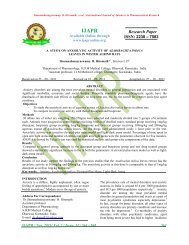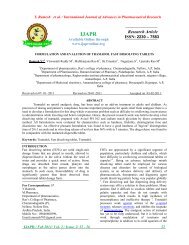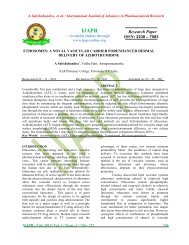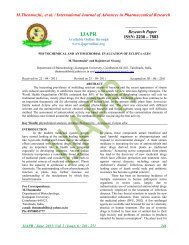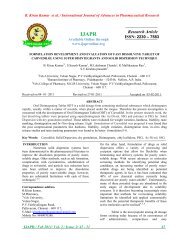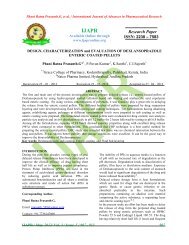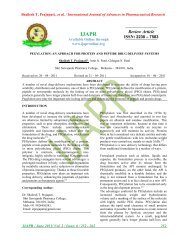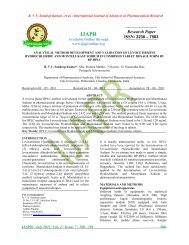formulation and characterizatin of transdermal patches by using ...
formulation and characterizatin of transdermal patches by using ...
formulation and characterizatin of transdermal patches by using ...
You also want an ePaper? Increase the reach of your titles
YUMPU automatically turns print PDFs into web optimized ePapers that Google loves.
Bismi P. Cheriyan et al. / International Journal <strong>of</strong> Advances in Pharmaceutical Research<br />
IJAPR<br />
Available Online through<br />
www.ijapronline.org<br />
Research Paper<br />
ISSN: 2230 – 7583<br />
FORMULATION, DEVELOPMENT & EVALUATION OF DICLOFENAC SODIUM<br />
TABLETS BY USING STARCH PHOSPHATE TO IMPROVE THE SOLUBILITY<br />
Bismi P. Cheriyan * , Tarkeshwar Prasad Shukla, Govind Mohan, Shailesh Sharma, Manmohan Kaushik.<br />
Department <strong>of</strong> pharmaceutics; NIMS University, Jaipur<br />
Received on 10 – 07 - 2012 Revised on 17 – 08- 2012 Accepted on 20– 09 – 2012<br />
ABSTRACT<br />
The objective <strong>of</strong> the study is to prepare, characterize & evaluate starch phosphate, a new modified starch as a<br />
carrier in solid dispersion for enhancing the dissolution rate <strong>of</strong> dicl<strong>of</strong>enac sodium. Dicl<strong>of</strong>enac sodium is among<br />
most extensively used NSAIDs: employed in rheumatoid arthritis & osteoarthritis, affords quick relief <strong>of</strong> pain &<br />
wound edema. Starch phosphate prepared <strong>by</strong> reacting potato starch with di-sodium hydrogen orthophosphate<br />
anhydrous at elevated temperatures was found to be a white, crystalline, non-hygroscopic powder. As starch<br />
phosphate exhibited good swelling in water, it is considered as a promising disintegrant in tablet <strong>formulation</strong>s. It<br />
was insoluble in water <strong>and</strong> has good swelling (400%) property without pasting or gelling when heated in water.<br />
Solid dispersion <strong>of</strong> dicl<strong>of</strong>enac sodium in starch phosphate were prepared <strong>by</strong> solvent evaporation method employing<br />
various weight ratio <strong>of</strong> drug : starch phosphate such as 1:1(F1),2:1(F2),1:2(F3),1:3(F4) & were evaluated for<br />
dissolution rate. Dicl<strong>of</strong>enac sodium (250 mg) tablets were prepared employing dicl<strong>of</strong>enac sodium alone & its solid<br />
dispersions F1, F2, F3 & F4 <strong>by</strong> wet granulation method & were evaluated. All the solid dispersion prepared gave<br />
rapid & higher dissolution <strong>of</strong> dicl<strong>of</strong>enac sodium when compared to pure drug.<br />
Keywords: dicl<strong>of</strong>enac sodium, starch phosphate, solid dispersion, dissolution rate.<br />
INTRODUCTION<br />
The solid dispersion technique to improve the<br />
dissolution characteristics <strong>of</strong> poorly water - soluble<br />
drugs <strong>by</strong> the use <strong>of</strong> water-soluble carriers [1] . Many<br />
water –soluble carriers polyethylene glycols,<br />
polyvinyl pyrrolidone [2,3] . According to literature<br />
review, the starch phosphate is used as carrier in<br />
solid-dispersion technique to improve the solubility<br />
<strong>of</strong> the drug. It is also used as disintegrating agent. No<br />
reports are available on its use as pharmaceutical<br />
excipient. The objective <strong>of</strong> the present study is to<br />
prepare, characterize <strong>and</strong> evaluate starch phosphate<br />
as a carrier in solid dispersions for enhancing the<br />
dissolution rate <strong>of</strong> dicl<strong>of</strong>enac sodium.<br />
Corresponding Author<br />
Ms. Bismi P. Cheriyan<br />
Department <strong>of</strong> pharmaceutics<br />
NIMS University, Shobha Nagar<br />
Jaipur, Rajasthan (303121)<br />
bismipcherian25@gmail.com<br />
91-8290814579<br />
MATERIALS & METHODS<br />
Dicl<strong>of</strong>enac sodium, starch phosphate is prepared in<br />
the laboratory, dichloromethane, potato starch,<br />
lactose, acacia, talc, magnesium stearate.<br />
[4, 5, 6]<br />
Preparation <strong>of</strong> starch phosphate<br />
Starch phosphate was prepared based on the method<br />
<strong>of</strong> Choi et al with some modifications. Potato starch<br />
(100 g) <strong>and</strong> di-sodium hydrogen orthophosphate<br />
anhydrous (30 g) were suspended in 100 ml <strong>of</strong> water<br />
<strong>and</strong> continuously stirred for 20 min. This starch<br />
slurry was then filtered <strong>and</strong> the wet starch mixture<br />
was conditioned for 12 h at room temperature<br />
(280C). To enhance phosphorylation, this mixture<br />
was heated in a forced air oven at 130°C for 3 h. The<br />
product obtained was ground <strong>and</strong> sized.<br />
IJAPR / Oct. 2012/ Vol. 3 /Issue. 10 / 1188 – 1192 1188
Bismi P. Cheriyan et al. / International Journal <strong>of</strong> Advances in Pharmaceutical Research<br />
8. Particle size: Particle size analysis was<br />
done <strong>by</strong> sieving <strong>using</strong> st<strong>and</strong>ard sieves.<br />
Figure no: 1 reaction on starch &<br />
disodium hydrogen O-phosphate<br />
[7, 8,<br />
EVALUATION OF STARCH PHOSPHATE 9] :<br />
Characterization <strong>of</strong> Starch Phosphate<br />
The starch phosphate prepared was evaluated for<br />
following<br />
1. Solubility:<br />
Solubility <strong>of</strong> starch phosphate was tested in water,<br />
aqueous buffers <strong>of</strong> pH 1.2, 4.5, <strong>and</strong> 7.4 <strong>and</strong> organic<br />
solvents such as alcohol, dichloromethane,<br />
chlor<strong>of</strong>orm, acetone <strong>and</strong> petroleum ether.<br />
2. pH:<br />
The pH <strong>of</strong> 1% w/v slurry was measured.<br />
3. Melting Point:<br />
Melting point was determined<br />
<strong>by</strong> <strong>using</strong> melting point apparatus.<br />
4. Viscosity:<br />
Viscosity <strong>of</strong> 1% dispersion in<br />
water was measured <strong>using</strong> Ostwald Viscometer.<br />
5. Swelling Index:<br />
Starch phosphate (200 mg)<br />
was added to 10 ml <strong>of</strong> water <strong>and</strong> light liquid paraffin<br />
taken in two different graduated test tubes <strong>and</strong><br />
mixed. The dispersion in the tubes was allowed to<br />
st<strong>and</strong> for 12h. The volumes <strong>of</strong> the sediment in the<br />
tubes were recorded. The swelling index <strong>of</strong> the<br />
material was calculated as follows.<br />
water – Volume<br />
paraffin ×100<br />
S.I (%) =<br />
light liqiud Paraffin<br />
Volume <strong>of</strong> sediment in<br />
<strong>of</strong> sediment in light liquid<br />
Volume <strong>of</strong> sediment in<br />
6. Test for gelling property<br />
The gelling<br />
property (gelatinization) <strong>of</strong> the starch <strong>and</strong> starch<br />
phosphate prepared was evaluated <strong>by</strong> heating a 7%<br />
w/v dispersion <strong>of</strong> each in water at 100°C for 30 min.<br />
7. Moisture absorption<br />
The hygroscopic nature<br />
<strong>of</strong> starch phosphate was evaluated <strong>by</strong> moisture<br />
absorption studies in a closed desiccator at 84%<br />
relative humidity <strong>and</strong> room temperature.<br />
9. Density: Density (g/cc) was determined <strong>by</strong><br />
liquid displacement method <strong>using</strong> benzene<br />
as liquid.<br />
10. Bulk density:<br />
Bulk density (g/cc) was<br />
determined <strong>by</strong> three tap method in a graduated<br />
cylinder.<br />
11. Angle <strong>of</strong> repose:<br />
Angle <strong>of</strong> repose was<br />
measured <strong>by</strong> fixed funnel method.<br />
12. Compressibility index:<br />
Compressibility<br />
index (CI) was determined <strong>by</strong> measuring the initial<br />
volume (Vo) <strong>and</strong> final volume (V) after hundred<br />
tapping <strong>of</strong> a sample <strong>of</strong> starch phosphate in a<br />
measuring cylinder. CI was calculated <strong>using</strong><br />
equation.<br />
Compressibility index (CI) = Vo – V × 100<br />
Vo<br />
Caliberation Curve<br />
100 mg <strong>of</strong> dicl<strong>of</strong>enac sodium was taken in a conical<br />
flask & dissolve in 100ml <strong>of</strong> pH 6.8 phosphate<br />
buffer.10 ml <strong>of</strong> solution was pipette out from above<br />
solution & diluted up to 100 ml with pH 6.8<br />
phosphate buffer. Now pipette out 1, 2, 3, 4, & 5ml<br />
solution from above solution & dilute up to 10 ml<br />
with pH 6.8 phosphate buffer. Measure the<br />
absorbance at 283nm <strong>by</strong> <strong>using</strong> UV visible<br />
spectrophotometer & plot the graph <strong>of</strong> concentration<br />
(µg/ml) versus absorbance.<br />
Table No1: Calibration curve<br />
CONCENTRATION ABSORBANCE<br />
0 0<br />
10 0.367<br />
20 0.595<br />
30 1.203<br />
40 1.502<br />
50 1.900<br />
Preparation Of Solid Dispersion Of Dicl<strong>of</strong>enac<br />
Sodium In Starch Phosphate [10, 11, 12] :<br />
Dicl<strong>of</strong>enac sodium was dissolved in<br />
dichloromethane (10ml) in a dry mortar to get a clear<br />
solution. Starch phosphate was then added <strong>and</strong><br />
IJAPR / Oct. 2012/ Vol. 3 /Issue. 10 / 1188 – 1192 1189
Bismi P. Cheriyan et al. / International Journal <strong>of</strong> Advances in Pharmaceutical Research<br />
mixed. The thick slurry was kneaded for 15 min. for<br />
complete evaporation <strong>of</strong> dichloromethane <strong>and</strong> then<br />
dried at 55°C until dry. The dried mass was<br />
pulverized <strong>and</strong> sieved through mesh no. 100.<br />
Preparation Of Dicl<strong>of</strong>enac Sodium –Sd [13, 14, 15] :<br />
Compressed tablets each containing 50mg <strong>of</strong><br />
dicl<strong>of</strong>enac sodium were prepared <strong>by</strong> wet granulation<br />
method employing dicl<strong>of</strong>enac sodium alone & its<br />
solid dispersion in starch phosphate in the ratio <strong>of</strong><br />
drug : starch phosphate (1:1), (1:2), (1:3), (2:1).<br />
Lactose was used as diluents to adjust weight to<br />
250mg. acacia 2%, talc 2% & magnesium stearate<br />
2% were incorporated respectively as binder &<br />
lubricants.<br />
Table no:2 description <strong>of</strong> trial taken<br />
INGREDIEN<br />
TS<br />
DICLOFEN<br />
AC<br />
SODIUM<br />
STARCH<br />
PHOSPHAT<br />
E<br />
F1(<br />
1:1<br />
)<br />
5O<br />
mg<br />
50<br />
mg<br />
DICHLORO 10<br />
METHANE ml<br />
LACTOSE 137<br />
mg<br />
ACACIA 4.4<br />
mg<br />
MAGNESIU 4.4<br />
M<br />
mg<br />
STEARATE<br />
TALC 4.4<br />
mg<br />
F2(2:<br />
1)<br />
50mg<br />
F3(1<br />
:2)<br />
50m<br />
g<br />
25mg 100<br />
mg<br />
10ml<br />
162m<br />
g<br />
4.4m<br />
g<br />
4.4m<br />
g<br />
10m<br />
l<br />
87m<br />
g<br />
4.4<br />
mg<br />
4.4<br />
mg<br />
F4(1<br />
:3)<br />
50m<br />
g<br />
150<br />
mg<br />
10m<br />
l<br />
37m<br />
g<br />
4.4<br />
mg<br />
4.4<br />
mg<br />
F5<br />
50<br />
mg<br />
-<br />
-<br />
187<br />
mg<br />
4.4<br />
mg<br />
4.4<br />
mg<br />
4.4m 4.4 4.4 4.4<br />
g mg mg mg<br />
WATER q.s q.s q.s q.s q.s<br />
Disintegration test<br />
To test for disintegration time, one tablet is placed in<br />
each tube <strong>and</strong> the basket rack is positioned in a 1<br />
litre beaker <strong>of</strong> water at 37°C+2°C. A st<strong>and</strong>ard motor<br />
driven device is used to move the basket assembly<br />
up <strong>and</strong> down through a distance <strong>of</strong> 5 to 6 cm at a<br />
frequency <strong>of</strong> 28 to 32 cycles per minute. When all<br />
six tablets have disintegrated, time is noted.<br />
F: IN-VITRO Dissolution test<br />
Dissolution rate was studied <strong>by</strong> <strong>using</strong> USP type II<br />
apparatus rotated at 75 rpm, 900 ml <strong>of</strong> phosphate<br />
medium. Temperature <strong>of</strong> dissolution medium was<br />
maintained at 37± 0.5 0 C. Aliquot <strong>of</strong> dissolution<br />
medium was withdrawn at specific time interval <strong>and</strong><br />
it was filtered. Absorption <strong>of</strong> filtered solution was<br />
checked out <strong>by</strong> UV spectroscopy at 283 nm & drug<br />
content was determined from st<strong>and</strong>ard curve,<br />
dissolution rate was studied for all designed<br />
<strong>formulation</strong> .<br />
RESULTS<br />
Evaluation <strong>of</strong> starch phosphate<br />
The starch phosphate was characterized on<br />
the basis <strong>of</strong> solubility, pH, melting point,<br />
viscosity, swelling index, angle <strong>of</strong> repose, bulk<br />
density, tapped density.<br />
Table No:3 Characterization <strong>of</strong> starch phosphate<br />
Sr.No. Property Result<br />
1. Solubility Insoluble in all<br />
aqueous <strong>and</strong><br />
organic solvents<br />
tested<br />
2. PH (1% w/v aqueous 7.25<br />
dispersion)<br />
3. Melting Point Charred at<br />
210 o C<br />
4. Viscosity (1% w/v<br />
aqueous dispersion)<br />
2.11 cps<br />
5. Swelling Index 400<br />
6. Gelling Property No gelling <strong>and</strong><br />
the swollen<br />
particles <strong>of</strong><br />
starch phosphate<br />
separated from<br />
water. Whereas<br />
in the case <strong>of</strong><br />
starch, it was<br />
gelatinized <strong>and</strong><br />
formed gel.<br />
7. Moisture Absorption < 4.0 %<br />
8. Particle Size 152 μm (80/120<br />
mesh)<br />
9. Density 1.667 g/cc<br />
10. Bulk Density 0.534 g/cc<br />
11. Angle <strong>of</strong> Repose 20.040<br />
12. Compressibility Index 11.01 %<br />
IJAPR / Oct. 2012/ Vol. 3 /Issue. 10 / 1188 – 1192 1190
Bismi P. Cheriyan et al. / International Journal <strong>of</strong> Advances in Pharmaceutical Research<br />
Figure no: 2 caliberation curve<br />
ratio. Among all the batches F10 shows high % drug<br />
release because F10 contain high amount <strong>of</strong> starch<br />
phosphate..According to all parameter <strong>of</strong> evaluation,<br />
batch F4 was optimized one, because it shows high<br />
% drug release when compared to other batch within<br />
30 min. & all other parameter was also found to be<br />
optimum for F4.<br />
ACKNOWLEDGMENT<br />
Authors are grateful <strong>and</strong> thankful to Dr. Balvir S<br />
Tomar, Chancellor & Dr. K.C. Singhal, Vice<br />
Chancellor NIMS University, Jaipur for providing<br />
necessary facility.<br />
Table No: 4 disintegration time<br />
<strong>formulation</strong> Disintegration<br />
time (sec.)<br />
F1 82<br />
F2 70<br />
F3 59<br />
F4 52<br />
F5 102<br />
Table no: 5 dissolution pr<strong>of</strong>ile<br />
TIME F1 F2 F3 F4 F5<br />
(MIN)<br />
0 0 0 0 0 0<br />
5 25.6 28.8 38.5 43.8 22.2<br />
10 40.9 44.5 62.3 66.7 35.1<br />
15 62.3 65.8 77.5 87.5 55.1<br />
20 73.2 76.7 85.1 94.5 69.9<br />
25 78.9 82.5 91.4 97.5 74.5<br />
30 90.8 91.4 94.5 98.2 87.4<br />
DISCUSSION<br />
The present work was carried out to formulate <strong>and</strong> to<br />
improve the solubility <strong>of</strong> dicl<strong>of</strong>enac sodium <strong>by</strong> <strong>using</strong><br />
starch phosphate. The flow property <strong>of</strong> starch<br />
phosphate was found to be good. The flow property<br />
depends upon the angle <strong>of</strong> repose & compressibility<br />
index & the value was found to be 20.04 0 & 11.01%<br />
respectively.<br />
The dissolution <strong>of</strong> all batches F1-F4 was compared<br />
with F5. F5 does not contain starch phosphate & all<br />
other batches contain starch phosphate in different<br />
REFERENCES<br />
1. Sekiguchi, & Obi, ‘Studies on absorption <strong>of</strong><br />
eutectic mixture’, Chemical Pharm.<br />
Bulletin, 1961,vol. 9, 866-872.<br />
2. Hirasawa, N., Ishise, S. & Miyata H., ‘An<br />
attempt to stabilize Nivaldipine solid<br />
dispersion <strong>by</strong> the use <strong>of</strong> ternary systems’.<br />
Drug Development <strong>and</strong> Industrial<br />
Pharmacy, 2003,vol. 29, 997-1004.<br />
3. Rawat, S. & Jain, S., ‘R<strong>of</strong>ecoxib-betacyclodextrin<br />
inclusion complex for<br />
solubility enhancement’, Pharmazie,2003,<br />
vol. 58, 639-641.<br />
4. Chowdary K.P.R.,Entury V.,Pallavi T.V.,<br />
“Formulation development <strong>of</strong> etoricoxib<br />
tablets <strong>by</strong> wet granulation & direct<br />
compression method employing starch<br />
phosphate- A new modified starch, Des<br />
pharmacia hetter,2011,3(6),163-172.<br />
5. Prashanthi N.L., Manikiran S.S., Rao N.R.,<br />
“Invitro drug release studies <strong>of</strong> ziprasidone<br />
from tablets <strong>using</strong> natural gums from<br />
biosphere”,<br />
Arch.Appl.Sci.Res,2011,3(2),513-519.<br />
6. Vaghela B.J,Kayastha R.R., Bhatt<br />
N.M.,Pathak et al “Formulation &<br />
evaluation <strong>of</strong> fast disintegrating tablet <strong>of</strong><br />
dicl<strong>of</strong>enac sodium”, Int.J.Pharm Res &<br />
Dev,2011,3(6), 17-22.<br />
7. Chowdary k.P.R, Entury V.,Rani<br />
A.S.,“Preparation <strong>and</strong> evaluation <strong>of</strong> starch<br />
phosphate- A new modified starch as a<br />
disintegrant in tablet <strong>formulation</strong>”<br />
Int.J.Chem.Sci,2011,9(2),889-899.<br />
8. P<strong>and</strong>ey V.P.,Reddy K.V.,Amarnath R.<br />
“Studies on diluents for <strong>formulation</strong> <strong>of</strong><br />
tablets”Int.J.Chem.Sci,2009,7(4),2273-<br />
2277.<br />
9. Prashanthi N.L., Manikiran S.S., Rao N.R.,<br />
“Invitro drug release studies <strong>of</strong> ziprasidone<br />
from tablets <strong>using</strong> natural gums from<br />
IJAPR / Oct. 2012/ Vol. 3 /Issue. 10 / 1188 – 1192 1191
Bismi P. Cheriyan et al. / International Journal <strong>of</strong> Advances in Pharmaceutical Research<br />
biosphere”,<br />
Arch.Appl.Sci.Res,2011,3(2),513-519.<br />
10. Meiczingen M., Dences J., Marton G., &<br />
Dences B. “Investigation <strong>of</strong> research<br />
occurring at starch phosphorylation,<br />
American chem. society-2005.<br />
11. Kumar S. & chowdary K.P.R.,<br />
“Formulation development <strong>of</strong> selected<br />
antiretroviral drugs <strong>by</strong> direct compression<br />
method”, Int.J.Pharmacy Sci,2012, 4(2),<br />
185-188.<br />
12. Chowdary K.P.R., Enturi V., “Enhancement<br />
<strong>of</strong> dissolution rate &<strong>formulation</strong><br />
development <strong>of</strong> efavirenz tablets employing<br />
starch citrate-A new modified starch”, J.<br />
Appl. Pharm Sci, 2011,1(5),119-123.<br />
13. Chowdary K.P.R., Ch<strong>and</strong>ra D.U., Parimala<br />
V.,Indira M., “A factorial study on<br />
<strong>formulation</strong> development <strong>of</strong> ibupr<strong>of</strong>en<br />
tablets employing stach 1500 & PVP K-30”<br />
Int. J. Pharma Sci Res,2012, 3(1),189-193.<br />
14. Jubril I.,Muazu J. & Moahmmaed G.T.<br />
“Effect <strong>of</strong> phosphate modified &<br />
pregelatinized sweet potato starches on<br />
disintegrant property <strong>of</strong> paracetamol tablets<br />
<strong>formulation</strong>s”,J. App. Pharm. Sci.,2012,<br />
2(2),32-36.<br />
15. Gunn’s <strong>and</strong> C, “Dispensing for<br />
pharmaceutical students”, 12 th edition,CBS<br />
publishers <strong>and</strong> distributors, 2006,11,188-<br />
189.<br />
INTERNATIONAL CONGRESS IN PHARMACY AND HEALTH SCIENCES<br />
Pharma Science Tech Association, Foundation No: AP/PSTA/56/2012.<br />
Please visit for Details: www.icphsmembership.com<br />
Totally three types<br />
FICPHS (Fellowship in International Congress in Pharmacy <strong>and</strong> Health Sciences), MICPHS (Member in International Congress in<br />
Pharmacy <strong>and</strong> Health Sciences), AMICPHS (Associate Member in International Congress in Pharmacy And Health Sciences)<br />
Eligibility<br />
FICPHS: Ph.D in Chemistry/ Pharmacy / M.Sc / M.Pharm with 2 years experience, MICPHS: M.Sc / M.Pharm (or) B.Sc / B.Pharm with<br />
2 years experience, AMICPHS: B.Sc (or) B.Pharmacy<br />
IJAPR / Oct. 2012/ Vol. 3 /Issue. 10 / 1188 – 1192 1192



